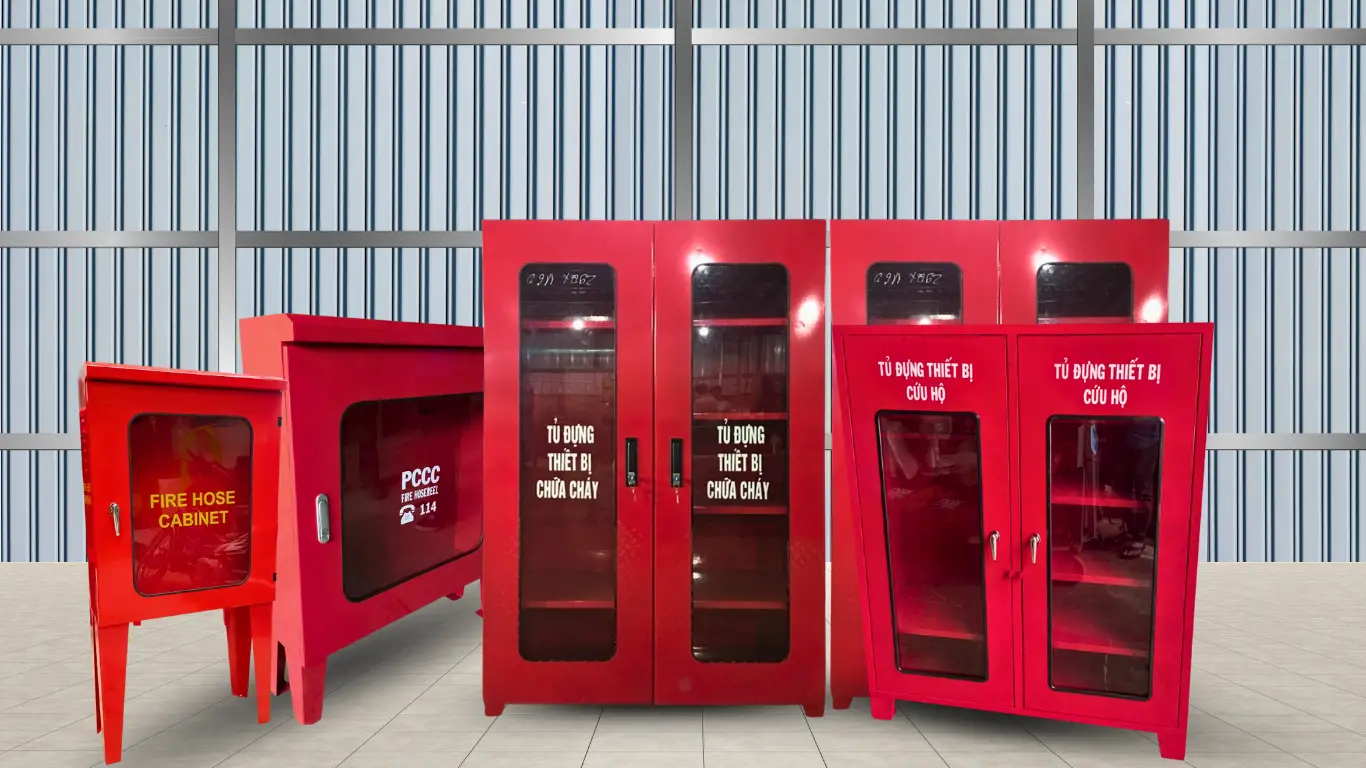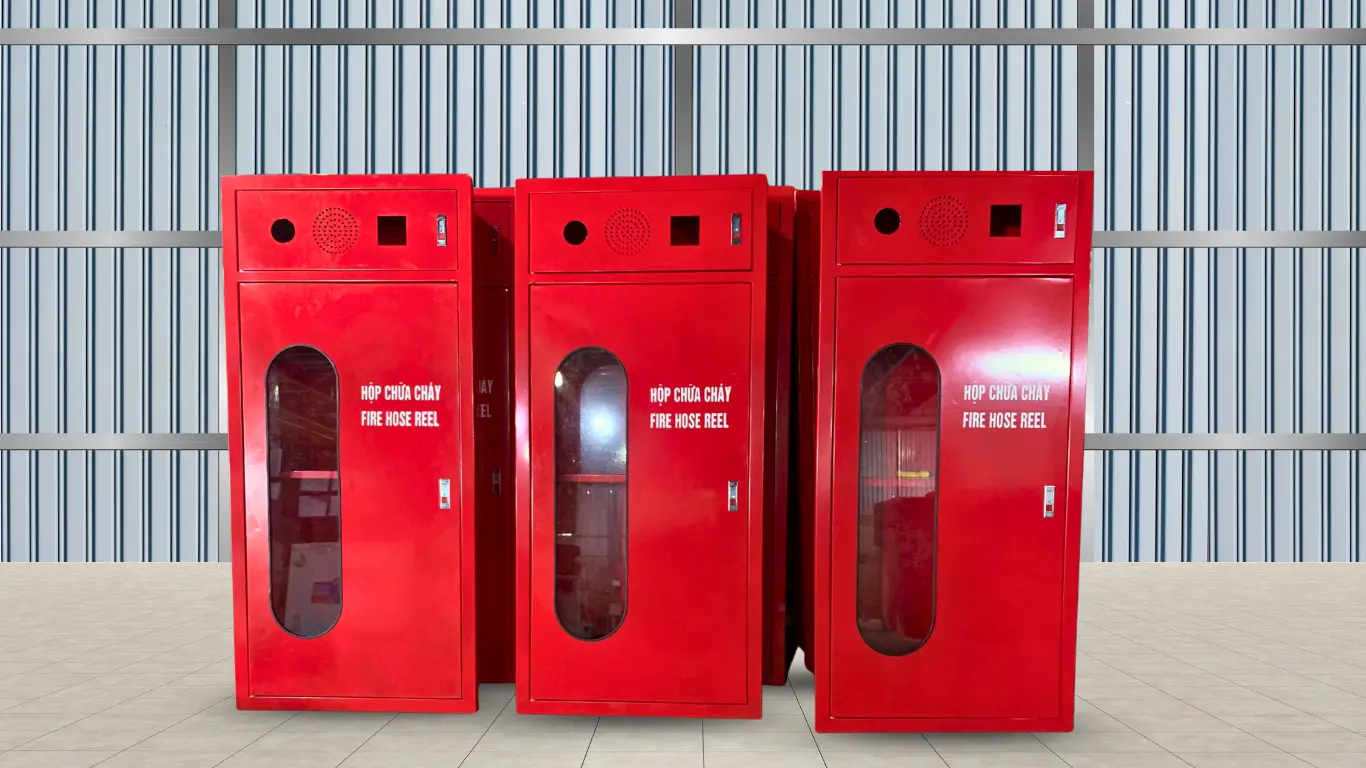An outdoor fire cabinet is a specialised protective device designed to store and protect firefighting equipment like fire extinguishers, fire hoses, nozzles, and more. It shields them from harsh weather and environmental factors. With its durable structure, high corrosion resistance, and easily identifiable design, this product is an essential choice for construction sites, industrial zones, factories, warehouses, and other locations.
Outstanding features of the outdoor fire cabinet
An outdoor fire cabinet is designed with several superior features to protect fire safety equipment comprehensively in harsh environments.
- The cabinet is made from high-grade powder-coated steel or stainless steel, giving it excellent resistance to oxidation, high durability, and the ability to withstand outdoor weather conditions.
- The cabinet door is equipped with a rubber gasket and a secure locking system for effective water and dust resistance, protecting the internal equipment from moisture and insects.
- A tempered glass window is designed into the door, allowing managers to easily check the status of the equipment inside without having to open the cabinet.
- Smart ventilation: Some models have small ventilation holes to regulate temperature, prevent mould, and keep the interior dry.
- The inside of the cabinet is equipped with sturdy hangers and brackets to neatly organise equipment such as fire hoses, nozzles, and fire extinguishers, making them easy to access when needed.
- The cabinet is typically painted a bright, prominent red to ensure it is easily visible from a distance, especially in low-light or chaotic conditions.
- The cabinets come in various standard sizes and can also be custom-fabricated to meet the specific requirements of each project, ensuring consistency and practical suitability.
Thanks to these features, outdoor fire cabinets not only ensure the safety of the equipment inside but also contribute to enhancing the professionalism, aesthetics, and overall effectiveness of the entire fire prevention and fighting system.

Basic Technical Specifications of Outdoor Fire Cabinets
To ensure optimal performance and meet the diverse needs of both residential and industrial applications, outdoor fire cabinets are designed with flexible specifications that suit various types of buildings and firefighting equipment. The following are some typical specifications:
- Materials: Powder-coated steel or stainless steel, with a thickness of 1.0 – 1.5mm.
- Common Sizes: 600x600x180mm, 700x500x220mm, 800x600x250mm (or custom-ordered).
- Paint Colour: Standard fire-fighting red, with a durable, scratch-resistant powder coating.
- Door Type: Hinged door with an optional lever handle, round lock, or key lock.
- Waterproof Gasket: Yes – a tight rubber seal is installed around the door edges to prevent water and dust.
- Viewing Window: Yes or no (depending on the model), made from tempered glass.
- Ventilation Holes: Optional – can be added upon request to prevent moisture.
- Included Accessories: Fire hose reel hook, fire extinguisher bracket, and dividers (if applicable).
- Top Cover/Canopy: Optional – helps protect the cabinet from direct sun and rain.
- Installation Method: Can be fixed to a wall, steel column, or support frame using bolts or expansion screws.
Practical Applications of Outdoor Fire Cabinets
More than just a simple protective device, an outdoor fire cabinet plays a crucial role in maintaining the readiness and operational effectiveness of fire prevention and fighting systems in a wide range of buildings. Thanks to its flexible design and excellent weather resistance, this product is widely used in various environments.
- Factories, industrial parks, and production facilities
- Apartment buildings, office towers, and shopping centers
- Gas stations, warehouses, seaports, and airports
- Schools, hospitals, and administrative buildings
- Public areas and outdoor corridors

Economic Benefits of Using an Outdoor Fire Cabinet
Beyond providing significant value in fire prevention and control, an outdoor fire cabinet also helps businesses and investors achieve sustainable cost savings. Here are the key economic benefits this product offers:
- Protects firefighting equipment from damage and corrosion.
- Ensures readiness and a proactive response in emergencies, thereby limiting property damage, production disruptions, and harm to a company’s reputation.
- Optimises maintenance and inspection costs.
- A one-time investment for long-term use: Made from durable powder-coated steel or stainless steel, the cabinet can reliably last for 5–10 years (or even longer with proper maintenance), providing an excellent return on the initial investment.
Outdoor Fire Cabinet Installation Guide
To ensure optimal performance and maintain the safety of your fire prevention and fighting system, an outdoor fire cabinet must be installed correctly according to proper procedures and technical standards. Here is a detailed guide:
Preparation Before Installation
Before starting work, make sure all necessary materials and equipment are ready:
- Fire cabinet (pre-checked for appearance and accessories)
- Fire hose reel, nozzle, and fire extinguisher (if applicable)
- Measuring tools: tape measure, marker, and a level
- Drill, drill bits, anchors, and bolts/screws
- Gloves, safety glasses, and other personal protective equipment (PPE)
Determining the Right Installation Location
- Easily Visible & Accessible: Install in an open location that is not obstructed by objects or landscaping.
- Close to High-Risk Areas: Such as warehouses, electrical substations, production facilities, and pumping stations.
- Appropriate Height: The cabinet opening should be 0.7m – 1.25m from the ground to comply with standard usage regulations.
- Mounting Surface: A concrete wall, steel column, or sturdy load-bearing frame, to ensure the cabinet does not shake or shift.
Detailed Installation Steps
- Mark the drilling points: Position the cabinet and use a marker to mark the screw points through the pre-drilled holes on the cabinet.
- Drill and install anchors/bolts: Use a drill to drill at the marked points, then drive in the anchors or place the fixed bolts.
- Align and secure: Place the cabinet in the correct position and tighten it using bolts or screws.
- Check for stability: Gently shake the cabinet by hand to check for any wobbling.
Organising and Using the Internal Equipment
- Open the cabinet door and arrange the fire hose reel, nozzle, and fire extinguisher in their correct positions, ensuring they are easy to access and use.
- Carefully lock the cabinet door after you have finished arranging the equipment.
Routine Inspection and Maintenance
- Monthly: Check the lock, viewing window, and rubber gasket to ensure the cabinet is sealed and easy to open.
- Quarterly: Check the internal equipment to ensure it is still within its expiration date and is functioning normally.
- Cleaning: Regularly wipe away dust and cobwebs, and remove any moisture or mildew to keep the cabinet clean and tidy.
Conclusion
An outdoor fire cabinet is more than just a simple protective device; it’s a crucial factor in enhancing the effectiveness of on-site fire prevention and fighting, ensuring the safety of people, property, and buildings. With its sturdy design, excellent weather resistance, and ease of installation and maintenance, the product is suitable for all types of projects, from residential to industrial and urban to production areas.
Investing in a high-quality fire cabinet is an economical, effective, and long-term solution that demonstrates responsibility and professionalism in fire prevention and control.
As a company with over 13 years of experience in supplying firefighting equipment, Thép Bảo Tín is committed to providing customers with high-quality outdoor fire cabinets that offer superior durability, reasonable prices, and dedicated after-sales service.
- Custom production – Fast delivery – Transparent pricing
Contact us now for a consultation and the best quote:
- Hotline: 0932 059 176
- Email: kinhdoanh@thepbaotin.com
Tiger Steel is a subsidiary of Bao Tin Steel.


 Tiếng Việt
Tiếng Việt ភាសាខ្មែរ
ភាសាខ្មែរ